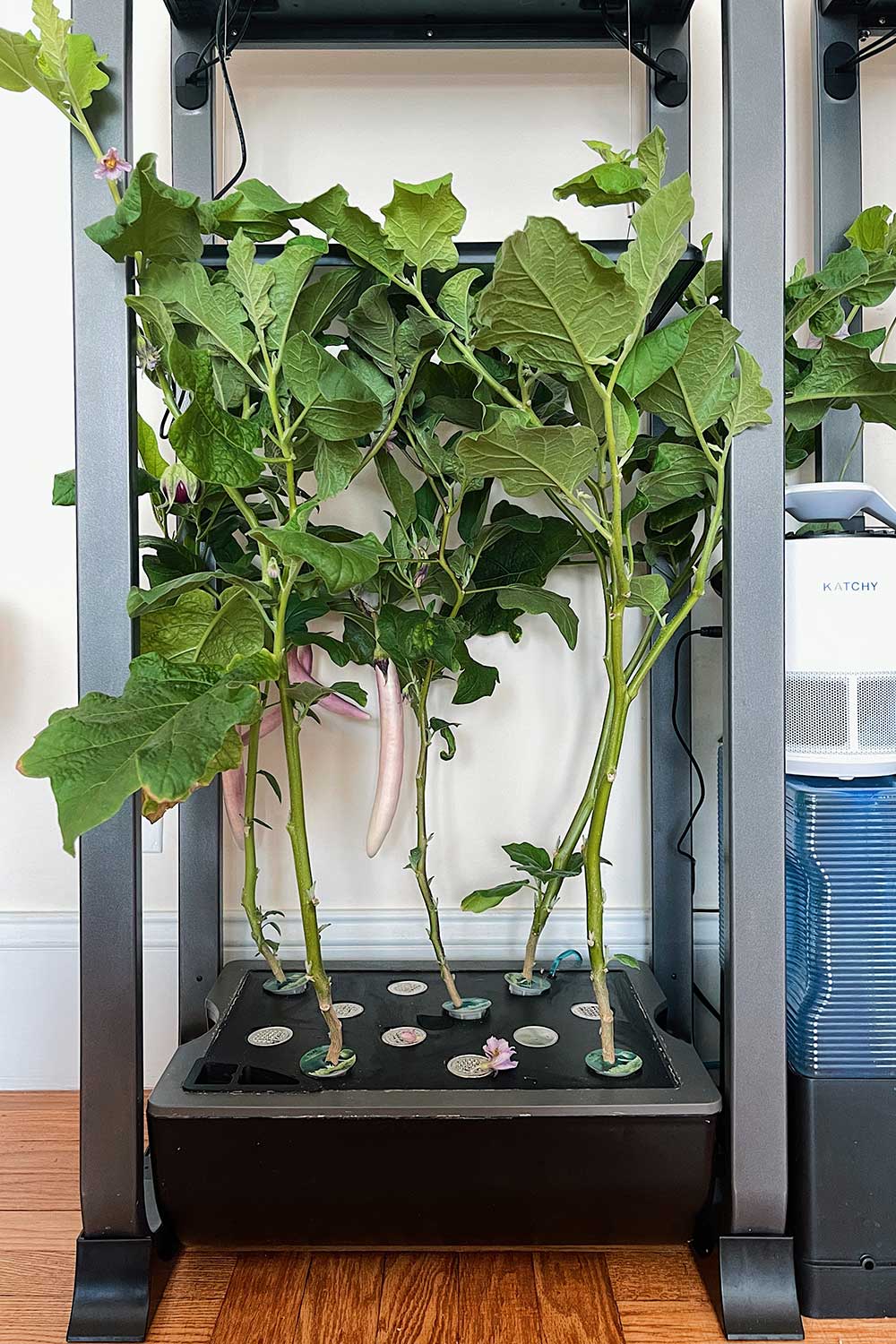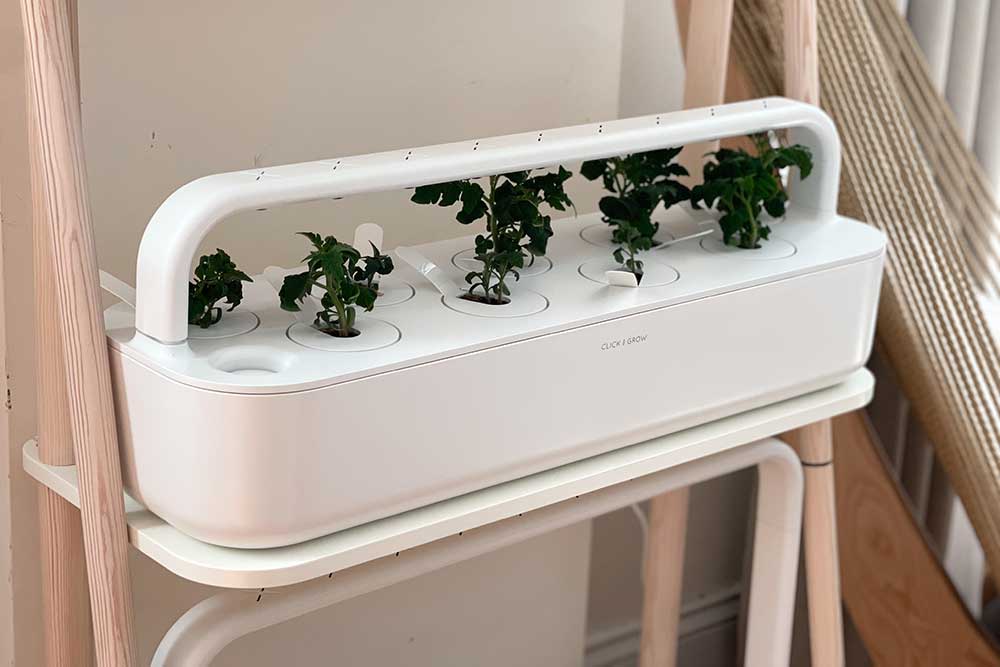
I’ve always wanted to grow my own herbs and veggies, but never really knew how. I also live in New York City and don’t exactly have outdoor space (or much indoor space either!)
That all changed when I got an Aerogarden several years ago, and discovered hydroponics.
Hydroponics
I started growing my own herbs, then graduated to cherry tomatoes and hot peppers and now have a fun mini garden in the limited space I do have!
And the best part is I can do it all year round, indoors, form the comfort of my home.
Hydroponics sounds complicated, but really it’s efficient, clean and fun – and much easier than you think.
If you’re like me and convinced you have black thumbs, hydroponics will change the way you approach gardening.
Here’s an in-depth overview to hydroponics, how to get started and a look at what you can grow!
What Is Hydroponics
Hydroponics is the technique of growing plants in water – hence, hydro.
With this style of growing, you don’t use any soil.
Instead, you use an inert medium to anchor the plant’s roots and then suspend the root systems in water.
Hydroponics can be done indoors or outdoors, but if you’re growing indoors, artificial LED lights provide the light source.
Basically, hydroponics is perfect for anyone with little to no gardening space, or those who want to extend their growing season through the winter.
Pros of Hydroponics
Hydroponics is great for a number of reasons.
1. No Time Limitations
The first is that it can be done indoors or outdoors – so you’re not limited to seasonal changes.
Here on the East Coast (I’m in zone 7) the growing season is short. Usually, anywhere from May to October of each year. With hydroponics, you can extend your growing season by starting seeds earlier, or by extending your plants later.
2. No Pests
But the biggest draw to me personally, was the lack of pests.
Because hydroponics calls for growing plants in water, without soil, you don’t get any weeds and you avoid soil based pests.
Knock on wood, I haven’t had any pest problems with my hydroponic systems so far (and it’s been 4 years!
So you can grow heirloom plants without harmful chemicals – which is important if you plan to eat what you grow.
3. Energy Efficient
Third, hydroponics can be quite efficient.
Water used in hydroponics is typically recycled and recirculated, so these systems actually use much less water than you’d think.
LED light bulbs are also pretty energy efficient, so they’re inexpensive to keep on for 12-16 hours a day.
Actually, that’s one of the most common questions I get – how have hydroponic kits affected my utility bills!
4. Higher Yields
Plants grown in a well managed hydroponic system can grow up to 5x faster than plants grown in soil.
Since the roots are bathed in water and all the nutrients that they need, plants in hydroponic environments can concentrate on growing upward, rather than growing their root systems to search for food.
And finally, if you’re tight on space, hydroponics can often grow plants vertically in a stacked manner, so you get more plants per square foot of space.
And, that means harvesting is easier! No need to crouch down to ground soil level.
In my book, hydroponics is definitely worth trying out.
Cons of Hydroponics
Of course, there are a few drawbacks to growing plants hydroponically.
1. Cost
Hydroponics doesn’t have to be expensive, but the initial setup can be an investment.
You can either buy hydroponic systems or DIY them yourself.
Personally, I prefer ready-made systems from Aerogarden, Click & Grow and Rise Gardens, because they’re easier to set up and more aesthetically pleasing!
I also think these systems pay for themselves over the long run.
Before I got my Aerogarden, I had never really successfully grown any type of plant or vegetable.
But I found the kit so easy to set up right out of the box and in just 30 days I had full grown fresh herbs – such a quick win!
Plus, the hydroponic models are reusable so they pay for themselves in yield and efficiency.
Nowadays there are lots of affordable indoor gardens on Amazon that are very cost effective for growing lettuces and greens.
2. Growth Limitations
The other main drawback to hydroponics is what you can grow.
If you plan to start seeds indoors to extend your growing season, and then transplant the seedlings outside, you can grow just about anything hydroponically.
But, if you’ll be growing indoors then hydroponics is best suited for plants that don’t produce fruit, like herbs and leafy greens.
One way to get around this is to grow compact varieties of fruiting plants, like cherry tomatoes instead of tomatoes. I’ve also experimented with hot peppers and had great results!
You can see more examples of what I’ve grown on my Youtube channel.
Getting Started with Hydroponics
There’s a couple basic components to getting started with hydroponic systems.
The easiest is to purchase a kit.
There’s all sorts of brands and models out there, but after doing a bunch of research I went with the Aerogarden Harvest.
You can read my in-depth review on it here, or watch my Youtube series here.
I also have a buying guide that compares all the different hydroponic kit options!
Build Your Own Hydroponics Set Up
Once you get more experienced (or if you’re on a budget or a handyman type) you can build your own.
There are a couple different type of systems, like kratky, deep water culture (DWC), ebb and flow and drip systems.
The simplest and most common is the kratky set up, where plants are grown in small pots and then suspended above a tank of water. As the roots grow, they hang down into the bucket and absorb both water and nutrients.
I have a tutorial on how to set up a Kratky mason jar system here if you want to do it yourself.
Kratky
Kratky hydroponic systems are the simplest to maintain and the least expensive to set up.
To build your own hydroponic system, you’ll need:
To build your own system, you’ll use some kind of container to act as your water reservoir.
Mason jars, 5 gallon buckets and heavy duty storage bins are all pretty popular.
In the container lid, you’ll house your plants inside a net cup.
Then inside the net cup, you’ll plant your seeds.
Seeds can be grown in all different types of growing mediums, but common options include rock wool, coconut coir, clay pebbles and cloning collars.
Then set up a water pump and timer to move water from the reservoir into the grow tray.
Using a garden tray, reservoir, water pump, and a few other miscellaneous hydro components, those looking to grow on a budget can get started pretty easily and for a fraction of the cost of a typical system.
And, because plants only receive oxygen, hydrogen and carbon in a hydroponic system, you’ll want to provide them with nutrients.
Typically, they’ll need things like nitrogen, phosphorus and potassium.
In an outdoor garden, you would add things like compost or fertilizer. But with hydroponics you need a bit more nutrients since there’s no soil. You can buy liquid fertilizer to add these to your hydroponic system.
With indoor hydroponic kits like the Aerogarden, Click & Grow and Rise Gardens, they’ll provide you with fertilizer so it’s even simpler.
Ebb and Flow
This method uses a pump on a timer to regulate the water + nutrient mixture.
Instead of a continuous stream of water, plant roots are flooded, then the water drains back into the reservoir. It’s a more efficient use of water and energy but requires more growing medium.
Drip System
This system uses drip lines to provide tiny drops of water for the plants. A timer sets a schedule to control the water and nutrient drip.
This is a bit more complex and usually used in commercial hydroponic set ups.
Aquaponics
Fish are added to the plants to create a symbiotic system!
Fish waste, which contain lots of nitrogen and can be harmful to them in high concentrations (but are nutritious to plants) are filtered out of the system and used by plants.
Aquaponics basically combines fish farming with hydroponics.
This isn’t something I’ve tried but I’d love to someday!
I do see that they sell small simple aquaponic systems online if you want to give it a go.
And that’s a quick guide to getting started with hydroponics!
Follow me on
